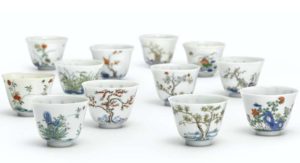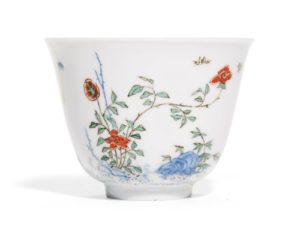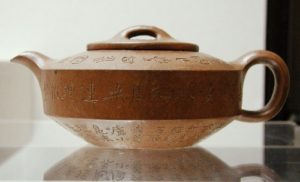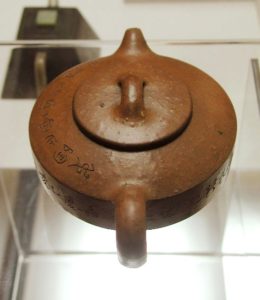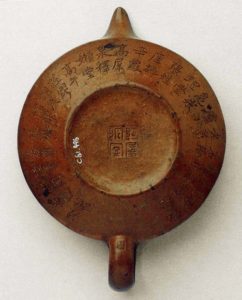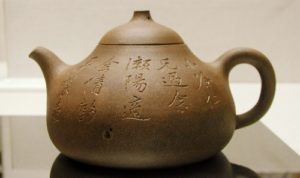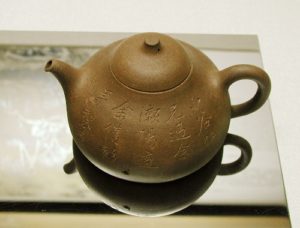Nestled inside Hong Kong Park, the Flagstaff House Museum of Tea Ware, formerly known as Flagstaff House, was built in the 1840s. It is the oldest colonial building in Hong Kong still standing in its original spot. As a branch museum of the Hong Kong Museum of Art, it was officially open in 1983. The core of the museum’s collection was donated by the connoisseur Dr K.S. Lo (1910-1995). Featuring an excellent collection of ceramics and Yixing teapots that reflect the unique culture of the time when it was made, the museum comprises about 600 teaware items and other related vessels dating from the Western Zhou (11th century BC-771 BC) to the twentieth century.
The upper floor gallery is home to a permanent display of the donated ceramics, which date from the Song to the Ming dynasties (960-1644) and include Ru, Ding, Guan, Jun and Ge wares from the five famous kilns of the Song dynasty (960-1279). Also exhibited are pieces produced at other celebrated kilns, such as Longquan and Cizhou, as well as Jingdezhen wares. The two-storey museum building also has a teahouse located on the ground floor, which serves Chinese tea and demonstrates the art of brewing.
For a great introduction by Raymond Tang, the head of the museum, of three beautiful Yixing teapots made by master potters, please watch the following video by Hong Kong Government:
Signature teaware
Twelve Cups in Wucai Style Representing the “Flowers of the Months”
Mark and period of Kangxi (1662 – 1722), Qing dynasty.
Height: 5 cm, Diameter: 6.5 cm
This is a set of twelve cups from the Kangxi period. The delicate eggshell bodies feature exquisite decorations, demonstrating the sophistication of wucai ware of the period. The flower of each lunar month has been outlined in black, before being depicted with cobalt blue and other enamels. The 12 flowers of the lunar cycle are prunus, apricot blossom, peach blossom, peony, pomegranate, lotus, rose, osmanthus, chrysanthemum, orchid, narcissus, and wintersweet. On the other side of each cup, a poem in five- or seven-character verses praises the flower. Many of these cups also carry a small square seal inscription of the character ‘ shang ‘, meaning ‘admired’. On the base, the mark of the Kangxi period is written in two rows of six characters in underglaze blue, in the regular kaishu script.
Wucai, which literally means ‘five colours’, refers to multicoloured porcelain ware with overglaze enamel decorations. By the latter part of the Ming Dynasty, in the 16th century, the overglaze colours of wucai wares had expanded to include red, yellow, green, brown and purple. By the Kangxi period of the Qing dynasty, the palette of overglaze colours was further enriched with the innovation of blue and brilliant black overglaze colours. These new colour palettes quickly took the place of the wucai wares painted with underglaze blue, a style which reached its zenith of development in the Ming Dynasty.
Teapot of Chamfered Low Cylindrical Shape
Seals: (Yang) Pengnian; Amantuo Shi (Chen Hongshou)
Inscription by Pinjia (Guo Lin) “Teapot number 1,379”.
Dated yihai year of Jiaqing period (1815).
Height: 7 cm, Width: 11.8 cm
“Mansheng teapots” are named after Chen Hongshou, also known as Zigong and Mansheng, a famous scholar-artist of the late 18th to the early 19th century who is celebrated as one of the “Eight Masters of Xiling”. A native of Qiantang in Zhejiang province, Chen excelled in painting, calligraphy, seal engraving and the study of inscriptions on ancient bronzes and stone tablets. It is said that when Chen was serving as a magistrate in Liyang County, he designed eighteen different styles of teapots and commissioned two leading potters, Yang Pangnian and Shao Erquan, to make them. Known as “Mensheng teapots”, these simple yet beautifully conceived vessels bear the seal marks “Pangnian” on the underside of the handle and “Amantuo Shi”, the name of Chen’s studio, on the base. Some are even inscribed with Chen’s poetry and signature. Cherished for their great artistic value that is derived from the combination of the arts of calligraphy, seal engraving, poetry and craftsmanship, “mansheng teapots” are fine examples of teaware produced from the excellent collaboration between artist-potters and members of the literati.
With its low, chamfered cylindrical shape, this “Mansheng teapot” has a broad, gently sloping shoulder and a short, curved spout. The seal mark “Pangnian” is impressed on the underside of the flattened handle, while the inscriptions on the teapot were done by Guo Pinjia, a friend of Chen. The lower belly of the teapot is engraved with fifteen names, presumed to be those of Chen’s friends who examined and appraised the teapot at a literati gathering.
Teapot of gourd shape
Seals: (Yang) Pengnian, Jihu
Inscription by Mansheng (Chen Hongshou)
Qing dynasty (Early 19th century)
The production of Yixing tea ware experienced a revival at the beginning of the 19th century, which emerged in tandem with the change in intellectual tastes. At that time, scholars liked to demonstrate their literary talents through painting, calligraphy and seal engraving on the plain, undecorated surfaces of teapots of simple shapes. Inscriptions of poetry, epigrammatic quotes and religious sayings are commonly found on the body of teapots as a result of collaboration between potters and scholars. The teapots therefore carry marks of both the potter and the owner’s studio.
Chen Hongshou (1768 – 1822), alias Zigong and with the sobriquet Mansheng, was an eminent scholar and artist from the Jiangnan region, active during the late Qianlong to early Daoguang periods. Chen is recorded as having designed eighteen teapot styles when he served as the Magistrate of Liyang (a neighbouring county of Yixing in Jiangsu province) and commissioned the two leading potters of the time, Yang Pengnian (1796 − 1820) and Shao Erquan (active in the early to mid-19th century) to make teapots. The teapots with the seal mark “Pengnian” under the handle, “Amantuo Shi” (name of Chen Mansheng’s studio) under the lid, and decorated with the poetry and signature of Chen Mansheng on the body, are known as “Mansheng teapots”.
Since the Ming dynasty, people preferred to prepare tea by steeping loose tea leaves in a teapot. This was called the “steeping method”. Apart from glazed teapots made of porcelain, those teapots made of purple clay from Yixing of the Jiangxu province were most treasured by the tea epicures in the Qing dynasty. The minute porosity yet impermeable nature of Yixing teapots makes their clay bodies highly absorbent. After long periods of use, the tea-stained interior of the teapots would enrich the flavor of the tea infusion by producing a stronger taste. The Yixing teapots were also cherished by the literati for their elegant designs and simple forms, which matched the aesthetic tastes associated with tea drinking at that time.
Tea Market
Get More Value from Your Tea: BRU Maker One
+41794574278
Jacque's Organics
(647) 804-7263
